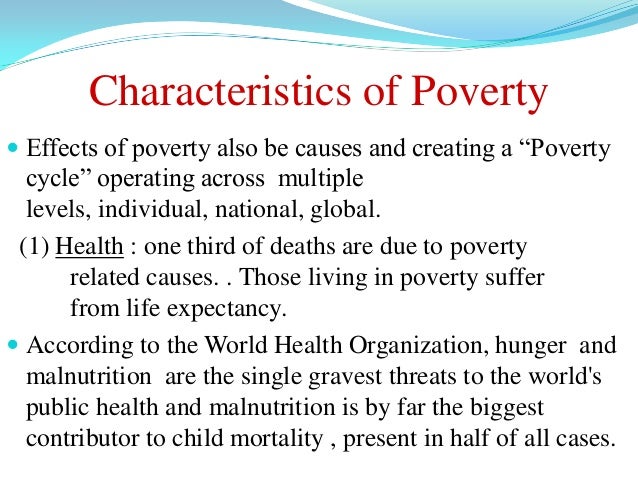Relevance: Challenges of Social Transformation: Poverty, deprivation and inequalities.
Poverty is a social condition that is characterized by the lack of resources necessary for basic survival or necessary to meet a certain minimum level of living standards expected for the place where one lives. The income level that determines poverty is different from place to place, so social scientists believe that it is best defined by conditions of existence, like lack of access to food, clothing, and shelter. People in poverty typically experience persistent hunger or starvation, inadequate or absent education and health care, and are usually alienated from mainstream society.
Causes of Poverty
Poverty is a consequence of the uneven distribution of material resources and wealth on a global scale and within nations. Sociologists see it as a social condition of societies with an unequal and inequitable distribution of income and wealth, of the de-industrialization of Western societies, and the exploitative effects of global capitalism.

Types of Poverty
- Absolute poverty is what most people probably think of when they think of poverty, especially if they think about it at the global level. It is defined as the total lack of resources and means required to meet the most basic standards of living. It is characterized by a lack of access to food, clothing, and shelter. The characteristics of this type of poverty are the same from place to place.
- Relative poverty is defined differently from place to place because it depends on the social and economic contexts in which one lives. Relative poverty exists when one lacks the means and resources required to meet a minimum level of living standards that are considered normal in the society or community where one lives. In many parts of the world, for example, indoor plumbing is regarded as a sign of affluence, but in industrial societies, it is taken for granted and its absence in a household is taken as a sign of poverty.
- Cyclical poverty is a condition in which poverty is widespread but limited in its duration. This type of poverty is typically linked to specific events that disrupt a society, like war, an economic crash or recession, or natural phenomena or disasters that disrupt the distribution of food and other resources.
- Collective poverty is a lack of basic resources that are so widespread that it afflicts an entire society or subgroup of people within that society. This form of poverty persists over periods of time stretching across generations. It is common in formerly colonized places, frequently war-torn places, and places that have been heavily exploited by or excluded from participation in global commerce, including parts of Asia, the Middle East, much of Africa, and parts of Central and South America.
- Concentrated collective poverty occurs when the kind of collective poverty described above is suffered by specific subgroups within a society, or localized in particular communities or regions that are devoid of industry, good-paying jobs, and that lack access to fresh and healthy food. For example, within the U.S., poverty within metropolitan regions is concentrated within the principal cities of those regions, and often also within specific neighborhoods within cities.
- Case poverty occurs when a person or family is unable to secure resources required to meet their basic needs despite the fact that resources are not scarce and those around them are generally living well. Case poverty might be produced by the sudden loss of employment, inability to work, or injury or illness. While it might at first glance seem like an individual condition, it is actually a social one, because it is unlikely to occur in societies that provide economic safety nets to their populations.
- Asset poverty is more common and widespread that income poverty and other forms. It exists when a person or household does not have enough wealth assets (in the form of property, investments, or money saved) to survive for three months if necessary. In fact, many people living in the U.S. today live in asset poverty. They may not be impoverished so long as they are employed, but could be thrown immediately into poverty if their pay were to stop.

Criticisms of the Concept of Poverty
Absolute poverty is difficult to measure because there is no universally agreed concept of ‘needs’, and the same criticisms can be applied to relative poverty – if we are to base the definition of this on not having certain items, then it is impossible to escape subjective interpretations of what the cluster of ‘necessary items’ should be.
The concept of relative poverty has also been criticised as only actually measuring inequality, rather than poverty, so the concept lacks clear meaning – – at least the concept of ‘absolute poverty’ helps us to identify people in real need, whereas it is not necessarily possible to say this about someone who is in ‘relative poverty’ when they level of it keeps rising with increasing standards of living.
Focusing on relative poverty detracts attention away from those in absolute poverty.
Some sociologists have moved away from the concept of poverty in favour of ‘social exclusion’ which focuses instead on the processes which deny poorer people access to certain citizenship rights.
Relevance

Research on poverty has demonstrated that a substantial amount of people in both the United Kingdom and the United States are in poverty at any one time, and that there is a clear link between socio-economic structures and the persistence of poverty in modern societies.

